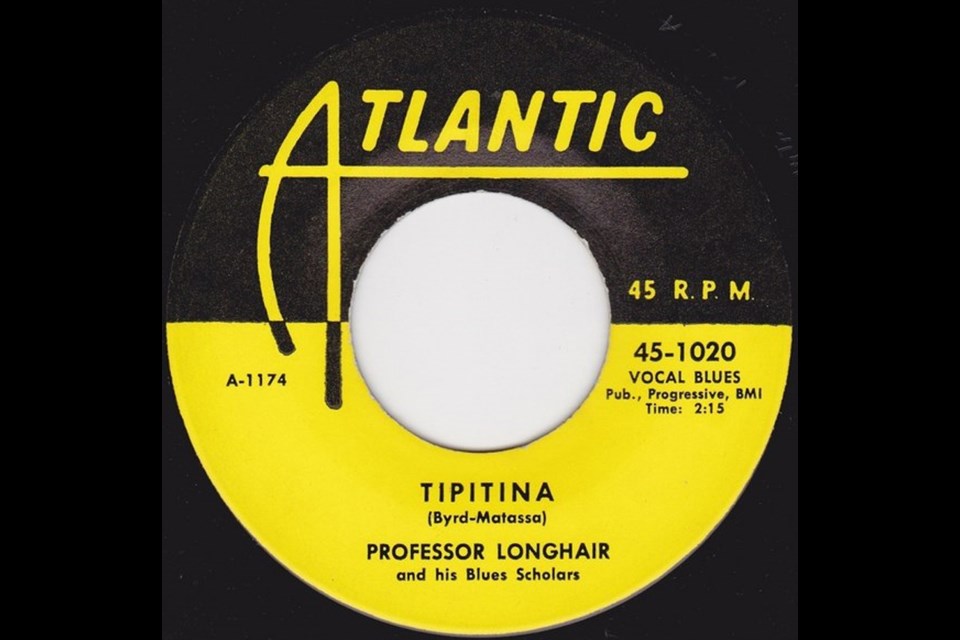New Orleans musician Henry Roeland “Roy” Byrd (Dec. 19, 1918 – Jan. 30, 1980) was born on this day 100 years ago in Bogalusa, Louisiana.
Like Jelly Roll Morton before him, “Fess” had a lot going on in his syncopated music. Jason Berry in The Daily Beast says, “Professor Longhair played piano with a parade inside his fingers. His romping keyboard style stretched the “Caribbean left hand” (in the words of Andy Kaslow, his last saxophonist). He captured a rhythm of feet on the street, melding simulations of up tempo horns layered in a strongly percussive flavor, resonant of the habanera or tango sound.”
Professor Longhair performed “Tipitina” with The Meters backing him up in 1974 as part of a "Dr. John's New Orleans Swamp" television show taped on the PBS Soundstage in Chicago.
“Tipitina” was released by Professor Longhair & His Blues Scholars as a single in 1953 on Atlantic Records in both 45 rpm (yellow label) and 78 rpm (red label) formats. Label honchos Ahmet Ertegun and Jerry Wexler had travelled to New Orleans in November, 1953 to record the song. J&M Recording Studios sound engineer Cosimo Matassa (a seminal link in the origins of rock ‘n’ roll) is also given a songwriting credit on the track which became a regional hit. “In the Night” was the B side.
The band on the recording session featured Roy Byrd (vocals, piano) playing with Lee Allen (tenor saxophone), Frank Fields (bass), Earl Palmer (drums) and Alvin “Red” Tyler (baritone saxophone).
In 2011 the Library of Congress added "Tipitina" to the National Recording Registry of sound recordings that "are culturally, historically, or aesthetically important, and/or inform or reflect life in the United States."
Ahmet Ertegun “discovered” Professor Longhair several years before he actually got to work with him. He talked about his first trip to find “Fess” in the late ‘40s with New Yorker writer George W. S. Trow in 1978, Eclectic, Reminiscent, Amused, Fickle, Perverse – II. Ertegun’s memory of an epic journey goes on for several hundred words and includes his first impression of the man. “The thing that struck me when we arrived there, when we walked in, what I thought had been an r&b band turned out to be just Professor Longhair by himself. He was sitting there with a microphone between his legs. He used to play an upright piano, and he had a drum, kind of a drum, attached to the piano. Not a drum but a drumhead, you know, attached to the piano. He would hit it with his right foot while he was playing. He made a percussive sound. It was very loud. And he was playing the piano and singing full blast, and it really was the most incredible-sounding thing I ever heard. And he was doing it all by himself. And it was one of the most primitive dance halls I’d ever been in. There was just like . . . a club, you know, but people jammed in there dancing and this wild thing going on, and they hid us in the corner there and we were listening to the music. I thought, My God, we’ve really found an original – nobody’s ever heard this man. He played like nobody I’d ever heard. Had some of the characteristics of some of the early boogie-woogie piano players, but with a strong Latin influence. He had a little bit of Jelly Roll Morton, a little bit of Yancey, a little bit of – But he played in his own time. He kept a very strange, different tempo. And a lot of Spanish influences – West Indian, you know. And it was just a strange mixture but the most marvellous thing I’d ever heard . . . “
Professor Longhair – Fess Up, a two-DVD set with a 38-page hardbound volume of archival images and commissioned essays, was released earlier this year. Disc one features Piano Players Rarely Ever Play Together, a 1982 documentary made by filmmaker Stevenson J. Palfi. Disc two features Fess Up, an archive film recorded at the piano with Henry Roeland Byrd at Tipitina’s in New Orleans in January, 1980, two days before he passed away. 2018 Louisiana Endowment for the Humanities Lifetime Achievement award recipient Ben Sandmel in a panel discussion on Professor Longhair at the 2018 New Orleans Jazz and Heritage Festival described the Fess Up package as “the most important historic reissue of New Orleans music and interview material since the complete Jelly Roll Morton Library of Congress interview from 1938 (by Alan Lomax).” The set is available online from the Louisiana Music Factory.
Tipitina’s, founded in 1977 as a place for Fess to perform in New Orleans, will host his 100th birthday blowout tonight featuring a long list of performers.



